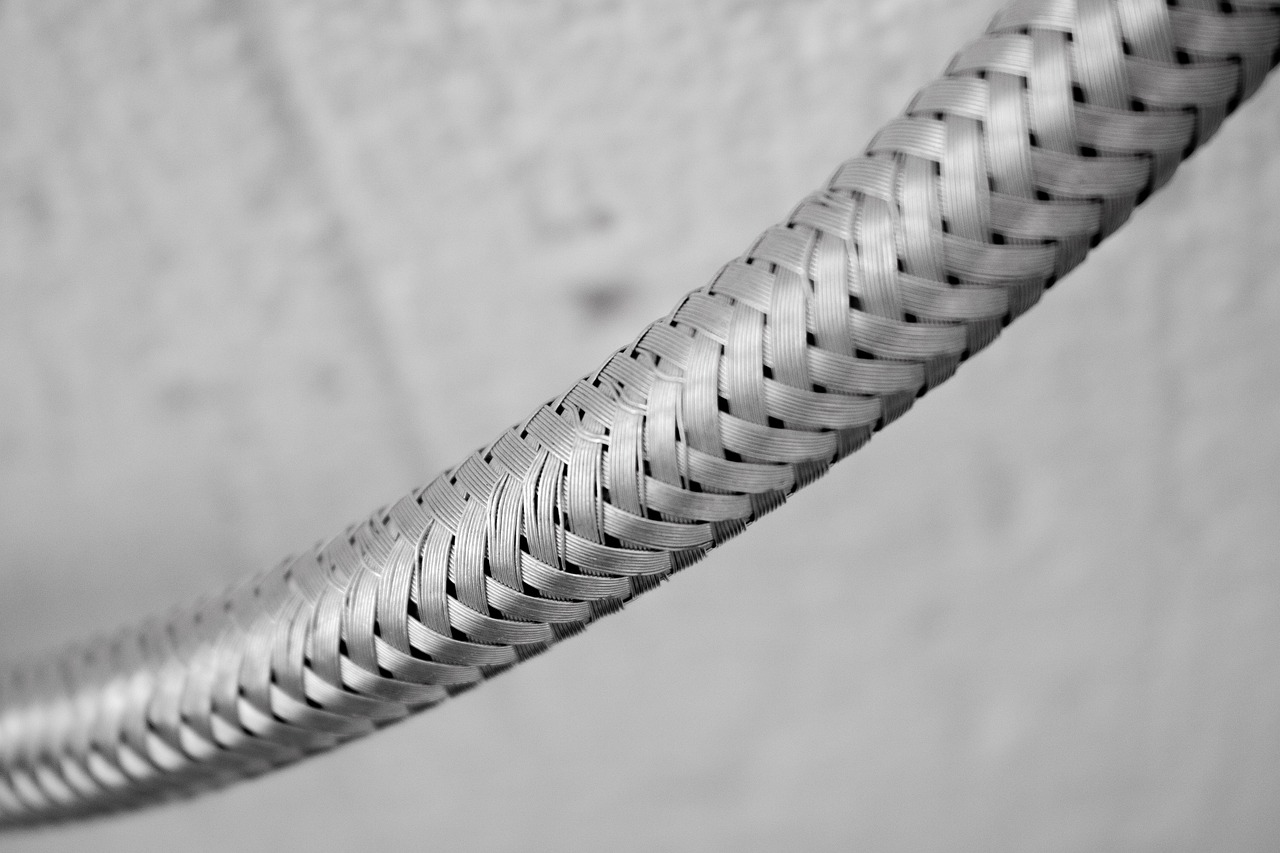Clients are able to receive a free 30-minute consultation with a company representative to get a better understanding of what they need.
Let Us Do the hard work for you

In the rapidly growing cannabis industry, ensuring cleanliness and sanitation is crucial for maintaining quality and safety standards. As the sector matures, it can draw important lessons from established industries like pharmaceuticals, particularly in areas of equipment hygiene and validation.
One component that poses unique challenges in terms of cleaning and sanitation is braided stainless-steel cables. These cables are commonly used in various cannabis equipment, and understanding the science behind the difficulties in cleaning them is crucial for improving overall sanitation practices.
In this article, we explore the complexities involved in cleaning braided stainless-steel cables, a critical component in cannabis equipment. We will examine the unique challenges they pose and discuss innovative strategies for ensuring cleanliness.
Additionally, we will highlight how these approaches align with and maintain compliance with GMP (Good Manufacturing Practices) and EU-GMP standards. By focusing on effective cleaning methods and adherence to these regulatory frameworks, we aim to provide insights into upholding the highest standards of safety and quality in cannabis production.
Braided stainless-steel cables are prized in the cannabis industry for their unique blend of durability and flexibility. Their intricate woven design, while lending strength, also introduces cleaning challenges. With a heightened surface area featuring many crevices, these cables can harbor dirt, bacteria, and other contaminants.
Traditional cleaning solutions, such as soap, detergents, or specialized chemical agents, may only address the surface concerns, often failing to reach deep within the intertwined braid layers.
The creation of refined cleaning procedures is vital to comprehensively tackle these specific surfaces. This necessitates the discovery and application of specialised cleaning instruments or methods with the ability to infiltrate the intricate architecture of braided cables. The need for regular checks and scrupulous upkeep of these cables cannot be overstated to avert metal contamination resulting from fraying or deterioration.
The emphasis should be not merely on surface cleaning, but on comprehending the complexities of the equipment’s structure, particularly the braided stainless-steel cables, to effectively eradicate potential microbial and metal contaminants. Recognizing these challenges, an alternative approach might be for manufacturers to consider equipment designs that do not rely on braided stainless-steel cables.
By doing so, they could potentially alleviate some of the cleaning complexities, better aligning with GMP regulatory standards and reducing potential contamination risks.
To meet the stringent guidelines of GMP (Good Manufacturing Practices) and EU-GMP (European Good Manufacturing Practices), manufacturers of cannabis machinery need to pay exceptional heed to the difficulties that come with cleaning the surfaces of equipment, especially braided stainless-steel cables.
These cables pose unique cleaning hurdles due to their detailed construction and large surface area, which can serve as a breeding ground for microorganisms, potentially causing contamination if not adequately maintained.
In recognizing and addressing the inherent challenges associated with the surface intricacies of braided stainless-steel cables, manufacturers not only underscore their allegiance to GMP and EUGMP standards but also cement their reputation for excellence. A forward-looking approach would be to invest in R&D to refine the design of these cables, paving the way for more streamlined cleaning procedures in the future.
According to the Eudralex – 4:
Cannabis equipment, notably those incorporating braided stainless-steel cables, often experiences varying temperature conditions. These temperature fluctuations can lead to condensation or moisture buildup within the cables, inadvertently creating a conducive environment for bacterial and microbial proliferation. Moreover, introducing certain cleaning agents to these cables can bring about potential challenges, including unwanted chemical reactions or corrosion.
This not only jeopardizes the cable’s structural integrity but also its performance. As such, the selection of cleaning agents is critical to preserve the integrity and longevity of these cables. Aligning with GMP regulations, it’s imperative that any chemical utilized for cleaning doesn’t compromise the product in any way.
As elucidated in Eudralex – Volume 4:
Contrastingly, equipment engineered in compliance with GMP and EUGMP standards often lean towards designs devoid of braided stainless-steel cables. Such alternatives offer distinct advantages in upholding cleanliness and ensuring safety standards. Primarily, these designs can weather temperature shifts without succumbing to moisture issues, thereby negating risks of microbial or bacterial infestations.
Furthermore, equipment devoid of braided stainless-steel cables are inherently less susceptible to corrosion caused by cleaning agents. This translates to sustained structural integrity and operational efficiency. By judiciously choosing cleaning agents tailored for these alternative equipment designs, cannabis production facilities can consistently achieve — and even surpass — cleanliness and regulatory benchmarks.
Conducting a comprehensive visual inspection of braided stainless-steel cables presents inherent difficulties, attributed to their complex woven design. Even when deploying advanced magnification tools, achieving a detailed assessment of every minute crevice remains a formidable challenge.
This becomes particularly concerning in industries such as healthcare and food processing, where maintaining impeccable hygiene is of utmost significance. Without adopting rigorous inspection methodologies, there exists a persistent risk of overlooking contaminants that could jeopardize the quality and safety of cannabis products.
In accordance with GMP and EUGMP guidelines, it’s imperative that production equipment undergoes rigorous scrutiny. For instance, as stipulated in Eudralex – Volume 4:
The complexities associated with cleaning braided stainless-steel cables call for innovative solutions to ensure proper sanitation in cannabis equipment. Manufacturers and producers should consider investing in equipment designs that avoid the use of braided cables altogether.
By opting for alternative cable designs, such as solid or coated cables, the cleaning process can be significantly simplified. These alternative designs have smoother surfaces, reducing the risk of contaminants getting trapped within the cable structure. This not only improves the cleanliness of the equipment but also streamlines the overall sanitation process.
Apart from choosing equipment with easier-to-clean designs, implementing hygiene best practices is essential for maintaining cleanliness in cannabis equipment. This includes regular cleaning and disinfection protocols, using appropriate cleaning agents that are compatible with the equipment materials, and training staff on proper sanitation procedures. Developing comprehensive Standard Operating Procedures (SOPs) that outline cleaning protocols and requirements can help ensure consistency and adherence to hygiene standards.
In the context of cannabis processing and manufacturing, adhering to Good Manufacturing Practices (GMP) or the European Union’s Good Manufacturing Practices (EU-GMP) is a fundamental requirement. These standards ensure that products are consistently produced and controlled according to quality standards, which is especially critical in the cannabis industry due to its impact on consumer health and safety.
A key aspect of meeting these standards is the validation of cleaning procedures. This involves rigorous testing to ensure that all equipment used in the processing of cannabis is thoroughly sanitized and free from contaminants. Such validation is not a one-time process but a regular, ongoing effort to maintain hygiene and safety standards.
Validation tests generally include:
Maintaining comprehensive records of these cleaning and validation processes is equally important. Documentation should include details of the cleaning procedures used, the results of validation tests, and any corrective actions taken in response to the findings. This record-keeping serves multiple purposes:
It is important to note that the complexity of equipment surfaces can significantly impact the ease and effectiveness of the cleaning process. For instance, equipment with braided stainless-steel surfaces poses a greater challenge compared to those with flat surfaces. The intricate design of braided surfaces can trap contaminants more easily, making them harder to clean and validate.
This adds an additional layer of complexity to the validation process, as more detailed and potentially varied cleaning methods may be required to ensure these surfaces meet hygiene standards. This complexity underscores the importance of designing equipment and cleaning procedures with validation in mind, especially in the highly regulated cannabis industry.
As delineated in Eudralex – Volume 4:
Collaboration between industry stakeholders, regulatory bodies, and equipment manufacturers is crucial for addressing the challenges associated with cleaning braided stainless-steel cables. Sharing knowledge, experiences, and best practices can lead to the development of industry-wide standards and guidelines for equipment cleanliness.
Seeking expert consultation from professionals with expertise in equipment hygiene and sanitation can provide valuable insights and guidance for implementing effective cleaning protocols in cannabis equipment.
Ensuring cleanliness and maintaining strict sanitation protocols in cannabis equipment, especially for components like braided stainless-steel cables, is fundamental for global industry standards in product quality and safety.
The complex design of these cables presents unique challenges that call for innovative cleaning solutions and a rigid adherence to hygiene best practices. By investing in equipment with more hygienic cable designs and establishing thorough cleaning protocols, the cannabis industry can address these challenges effectively.
The adoption of these practices is not only beneficial for the Canadian market but has global implications. It raises the bar for safety and quality in cannabis production worldwide. Collaborative efforts and seeking expertise in this field are key to advancing industry standards. This involves a commitment to continuous improvement in equipment design and cleaning processes, ensuring the highest level of cleanliness.
As the cannabis industry expands globally, emphasizing efficiency in cleaning processes and hygiene will be crucial in producing safe, high-quality products. This approach not only meets consumer expectations but also reinforces the industry’s commitment to health and safety standards, fostering trust and credibility in the global market.

MFLRC is a one-stop shop for all of your Licensing, quality assurance and compliance needs. Our team has years of experience in the cannabis industry and are experts in all facets. We offer a variety of services that will save you time and money. Let us take the burden off your shoulders so you can focus on what’s important – growing your business.
Contact us Now!
Mussarat Fatima, President, and owner of MF Cannabis License and Regulatory Consultants has more than twenty years of experience in Quality Assurance, Quality Control, and Regulatory Affairs within the pharmaceutical, Food and Cannabis industries. She has a Master’s Degree in Food Sciences and Biochemistry; in addition to this, she also has a diploma in pharmaceutical Quality Assurance, Regulatory Affairs, and Quality Control. Also, she has completed several certifications specifically in Cannabis Quality Assurance, Regulatory Affairs, and Facility management from recognized institutes in Canada.

Written By: Mussarat Fatima
President at MF License & Regulatory Consultants
Website: https://mflrc.com/
Contact: info@mflrc.com